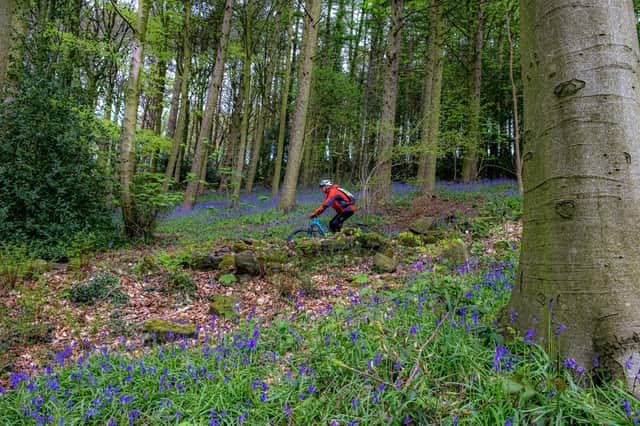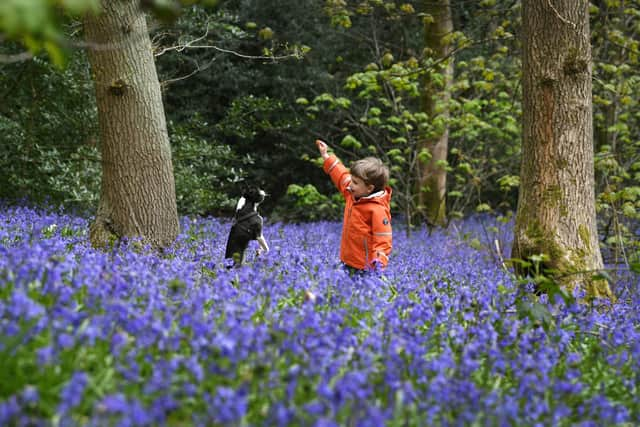Best places in Yorkshire to see bluebells


We have put together facts about bluebells and highlighted some of the best places in Yorkshire that will be carpeted in blue until early next month.
Flower facts
1 Bluebells can be found until early June when the flowers can make the most of light reaching the forest floor before the full woodland canopy casts its shade. 2 They can provide a valuable, early source of nectar for bees, hoverflies, butterflies and other insects.3 Occasionally you will spot white bluebells in amongst the violet - this is caused by a genetic mutation4 Half of the world's population of bluebells are in the UK.5 Bluebells are an ancient woodland indicator - meaning that they commonly appear in areas that have been wooded since 1600AD, and reply upon the unique conditions this habitat can provide.6 Trampling is not the only threat that bluebells face: Since 1998 it has been illegal for anyone to pick native bluebells from the wild for sale.


Best places to see bluebells in Yorkshire include:
Esholt Woods, West Yorkshire
Advertisement
Hide AdAdvertisement
Hide AdEsholt Woods are really about four woods under one name, Sping wood, Belmont wood, Jerrison wood and Sodhall Hill wood. It is not an easy place to find and parking is on the side of the road round a quiet housing estate before a short walk down the side of a field to the woods.
It is a pleasant place to walk though access is not good and the paths though wide are not suitable for wheelchairs. There is a large area to explore great for the children to run about in.
Middleton Woods, Leeds
Middleton Woods is the largest remaining ancient woodland site in West Yorkshire and is of special importance for nature conservation in Leeds. There are also many historical and archaeological features, including bell pits, from early coal mining and the former routes taken by trams.
Now is a wonderful time to enjoy the woodland as wildflowers are at their most abundant and bluebells, wood anemone, wood sorrel and lesser celandine cover the ground.
Temple Newsum, Leeds
Advertisement
Hide AdAdvertisement
Hide AdFree vast parkland with a walled garden and woodland. There is also a farm park with rare breed animals, a house you can look round and playgrounds. There is a cafe and toilets.
Fishpond Wood, Bewerley, Pateley Bridge
This is one of the area’s hidden secrets. Tucked away in Bewerley, it is a rare and regionally important example of a designed landscape from the 18th century. It has recently undergone some restoration work through the Upper Nidderdale Landscape Partnership, including repairs to the wonderful ice house and maintenance to the pond.
Hackfall, near Harrogate, North Yorkshire
The ancient woodland has been restored to its former glory, and boasts original features such as grottos and glades, rustic temples and waterfalls, as well as carpets of bluebells in spring and an impressive number of woodland birds.
Nidd Gorge, near Harrogate, North Yorkshire
Stroll among ancient woodland, take part in an adventure trail, and keep your eye out for roe deer, tawny owls, herons and woodpeckers.
Raincliffe Woods, Scarborough
Advertisement
Hide AdAdvertisement
Hide AdRaincliffe Community Wood is many things. It is a woodland open to the public every day.
Raincliffe Woods represents a fresh way of working with the local community to create a better environment, provide employment training and a career-building initiative.
Millington Wood Nature Reserve, Pocklington, East Yorkshire
It is one of the richest botanical woodlands in the East Riding and is a Site of Special Scientific Interest.
In spring and summer, wild garlic and bluebells fill the wood with colour and scent Millington Wood, which covers 52 acres, was declared a Local Nature Reserve in 1991.
Skipton Castle Woods, North Yorkshire
Advertisement
Hide AdAdvertisement
Hide AdThese ancient woods have a fascinating history and lie alongside Skipton Castle in the heart of the town.
They contain a wide variety of plants and amazing wildlife such as kingfishers, bats and deer, with some excellent pathways which follow the canal and the castle ramparts. Accessed from Skptn high street.